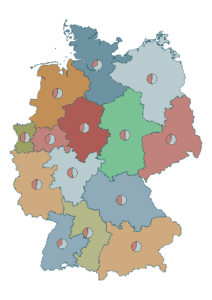Territory Alignment
In general, territory structures specify the assignment of customers to employees. If an employee has been assigned an above average number of customers with corresponding potentials while another gets too few, potentials in one territory will be worked on with an insufficient capacity while in another territory resources are not utilised adequately.

Example of a territory structure
Since market situations can develop differently regionally, an adjustment of the territory structure at regular intervals avoids wasting sales investments.
In order to meet these requirements, initially an inventory of the relevant success factors and of the available data must be carried out. Depending on the product portfolio to be discussed, different [sets of] information may play a role here.
We compile all relevant information and transfer the data into a geographic information system.
In order to achieve a result ideal for the penetrating power of the product reviews, we take into consideration the following issues by default when building the territories:
- The realisation of the ideal support of the relevant customer groups by the employees is made possible.
- To the extent possible, established successful customer relationships remain preserved.
- The territories to be built can be worked with ease since specifics of the infrastructure such as motorways, natural barriers, etc. are taken into consideration.
- The splitting up of cities is minimised.
- Employees’ places of residence are taken into consideration.
In a joint workshop, the first draft will be discussed in terms of regional and employee-specific requirements and jointly finalised. Subsequent to the completion of the territory structure, a comprehensive documentation is carried out in the form of territory and customer change lists as well as maps in order to perfectly support the implementation by the employees.
TOUR-OPTIMIsED TERRITORY ALIGNMENT
In the healthcare sector, the creation of territory structures based on workload (number of planned visits per territory) is widely accepted as a practicable approach. However, territories are usually not only characterised by a different number of target customers, but also by heterogeneous regional conditions. While some areas, e.g. the Ruhr area, are characterised by regional concentration, the exact opposite often applies to the majority of areas in eastern Germany.
Due to these regional differences, tour planning is of particular importance here. Only in this way can the existing efficiency reserves be used to further minimize geographical disadvantages and at the same time achieve the desired coverage, frequencies and call intensity per customer.
In contrast to the classical methods of territory structuring, in which regional differences are taken into account rather pragmatically, there is also the possibility of structuring the areas in a way that is optimised for tours.
INITIAL ANALYTICAL SOLUTION
We have a two-tiered approach to tour-optimised territory structuring. First of all, a purely analytical optimisation of the areas is carried out as the initial solution. However, in the course of this, important framework conditions and restrictions can of course be taken into account (e.g. residential locations, established customer relationships, etc.).
INTEGRATION OF EXPERT KNOWLEDGE
In a second step, SALETELLIGENCE refines the initial solution and optimizes the quality by integrating customer knowledge in an interactive workshop.
RESULT: BALANCED Territories ACCORDING TO TRAVEL AND VISIT TIME
Overall, the combination of mathematical optimization models with qualitative expert knowledge results in a tour-optimized, ideally manageable and sustainable territory structure. In order to optimize the continuous processing of the territories and make it efficient, our dynamic tour planning can be used.
